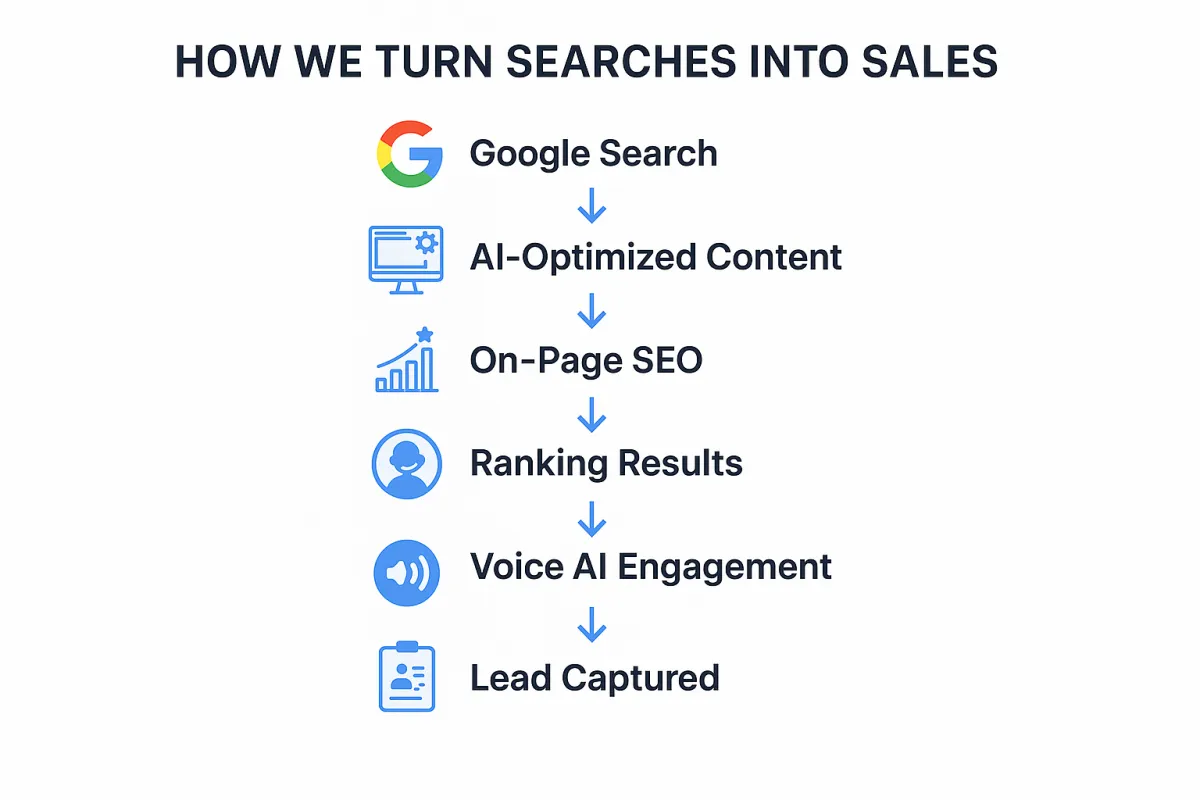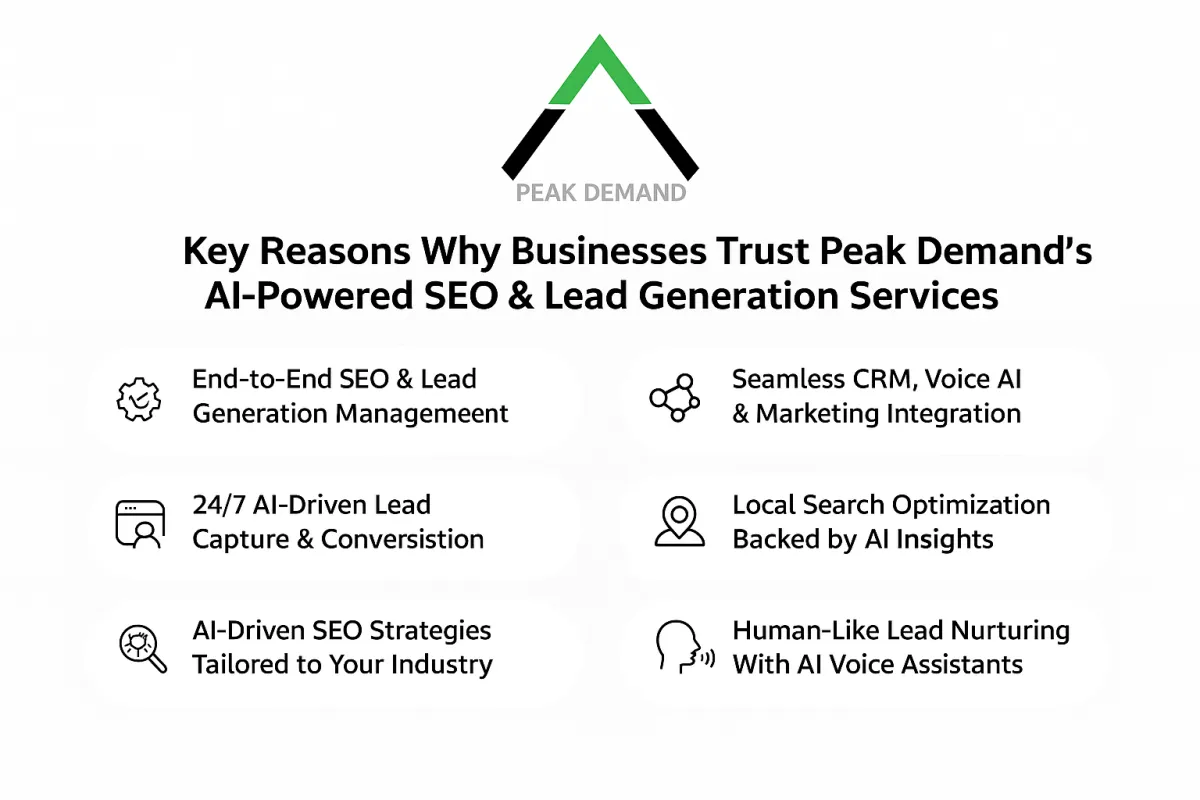AI Agency Automation Services & SEO
Toronto, Ontario, Canada
Let's climb to the top of your market, one custom automation at a time.
Phone: +1 (647) 691-0082
Email: [email protected]
Automated Voice AI Call Centre Using AI Agents with Personality
Agents that Work 24/7 - No Hold Times
Dedicated Phone Numbers
Speak to Multiple Customers
Speak in Multiple Languages
Customized Personality and Accents
Trained On Any Service or Document
Book Appointments Onto Calendars
Update CRM After Data Extraction
Provide Post Call Reports
Never Take Breaks
Never Get Tired
Never Retire
Customer Service Operations, Technical Support, Sales, After Hours
AI News, AI Updates, AI Guides

How the MLS Works — 25 Questions Real Estate Agents & Brokers Ask (US & Canada)
How the MLS works: this concise guide helps real estate agents and brokers in the US and Canada run accurate listings, approve vendors safely, spot data errors quickly, and run AI pilots in confidence.
Quick overview: What is the MLS and why it matters

The MLS (Multiple Listing Service) is the regional database real estate professionals use as the authoritative record for a property’s price, status, photos and showing instructions. It’s where brokers post listings and where agents go first to confirm facts before they call a buyer, schedule a showing, or publish a marketing link — make checking the MLS a habit on every call.
Each MLS is run by a local board or association that sets access rules, decides which fields are public versus broker-only, and enforces photo and attribution requirements. In the United States you’ll find many regional boards with varying platforms and policies; in Canada, boards commonly surface data through REALTOR.ca / DDF and have slightly different display rules. Regardless of country, the local board is the gatekeeper for how MLS data is used.
Brokers and agents treat the MLS as the “listing truth” because entries are created and maintained by licensed professionals and policed by the board. Accurate MLS data reduces phone confusion, speeds up showings, lowers dispute risk, and makes downstream tools — CRMs, websites, or AI pilots — far more reliable and effective.
25 Common MLS Questions for Agents & Brokers — Vendor Access, Listing Accuracy, Security & AI Pilots

MLS FAQ for agents and brokers: here are 25 common, search-friendly questions about vendor access, listing checks, security, and running AI pilots — with short, actionable answers you can use today.
Vendor access & permissions (Questions agents search for)
Who must sign to give a vendor MLS access?
The broker-of-record (or an authorized officer) usually signs the board’s vendor/data-use agreement to authorize third-party access.What paperwork does a vendor need for MLS access?
Most boards require a vendor licence or data-use agreement, proof of insurance, and a named vendor contact for onboarding.Can I limit what a vendor can see in the MLS?
Yes — brokers can restrict vendors to only the specific fields and actions they need (for example: read price/status but block broker-only notes).How do I revoke a vendor’s MLS access quickly?
Ask the board for the revocation process up front, keep the vendor agreement and contacts on file, and notify the board and vendor to remove credentials immediately.What is an MLS sandbox and why should I ask for it?
A sandbox is a test feed or dataset for demos and AI pilots so you can validate behavior without touching production listings or calendars.
Listing data & accuracy (Questions agents search for)
What information is in a typical MLS listing?
Common fields include MLS#, list price, status, photos, beds/baths, square footage, public remarks, agent contact and showing instructions.Why should I always confirm the MLS number (MLS#)?
The MLS# is the single, reliable identifier for a property and prevents lookup or booking mistakes across similar addresses.Which fields should I check live before calling back a lead?
Verify list price and status live; everything else (photos, full description) can be texted or emailed if necessary.Who fixes a wrong listing and how fast will it be corrected?
Contact the listing agent first; if unresolved, escalate to the MLS board support and log your request until corrected.What makes a listing look untrustworthy?
Missing photos, contradictory fields (e.g., DOM vs. list date), or no showing instructions — verify these before relying on the listing.
Lead handling, booking & routing (Questions agents search for)
Can an automated system book showings from MLS data?
Yes — with agreed rules and calendar/showing-scheduler credentials, systems can create tentative holds or confirmed bookings per your policy.How do we prevent double-bookings when automating holds?
Use instant calendar checks, short tentative holds, and require agent confirmation for priority time slots; always write holds to the CRM.How should “hot” buyer leads be routed?
Set simple qualifiers (pre-approval, budget threshold, urgent timeline) and route matches to immediate transfer, priority callback, or an agent alert.Will agents get caller context on transfers?
They should — warm handoffs include caller name, listing ID and a brief intent summary so agents don’t start cold.How do we tag and track AI-generated leads in the CRM?
Add a clear source tag (e.g., “AI-Receptionist”), include listing_id and intent in the lead note, and review quality weekly.
Security, privacy & compliance (Questions agents search for)
Should we store call recordings and for how long?
Only if you choose; set a retention window (commonly 30–90 days), document it in policy, and follow local privacy laws.How can I verify a vendor’s security practices?
Request a short security summary: TLS transport, encryption at rest, secrets management, retention windows and breach notification SLA.What are common MLS display and photo rules I must follow?
Boards often require exact attribution text or logos on public links and have rules on photo redistribution — follow the board’s required wording.How do I capture caller consent for recording and SMS?
Use a short script at the start of the call (e.g., “May I record this call and text you the listing link?”) and log the yes/no in the CRM.What’s the immediate step if there’s a data breach?
Isolate affected systems, rotate credentials, notify broker-of-record and the board per contract, and follow legal notification requirements.
AI pilots, testing & ops (Questions agents search for)
How long should an AI pilot run to be meaningful?
Typically 2–4 weeks or a few hundred calls — enough time to validate lookups, bookings, CRM writes and agent handoffs.What KPIs should we track during an AI pilot?
Track live lookup success rate, bookings per 100 calls, CRM write success, fallback rate, and agent satisfaction.How do we run a safe AI pilot without disrupting calendars?
Use sandbox credentials, test calendars, synthetic calls and a staging phone number so production schedules and live listings are not affected.What happens if a board rate-limits or blocks queries?
Use graceful fallbacks (text the listing link, queue SMS, or route caller to an agent) and have the vendor manage retries per board rules.When is it safe to move an AI pilot to production?
Move to production after KPIs meet agreed thresholds, security checks pass, broker sign-off is obtained, and agents are trained on the handoff/playbook.
Practical cheat-sheet: What to check in every MLS listing (for Brokers, Agents, Buyers)

For Brokers (ops & compliance)
Listing status & history — why: status mistakes create legal risk and unhappy clients. Do this now: verify Active/Pending/Sold and note recent status changes.
Price change log — why: frequent drops can signal stale marketing or motivated sellers. Do this now: capture last price change and date.
Required fields present — why: missing photos/measurements reduce leads and break integrations. Do this now: flag incomplete listings for immediate correction.
Broker-only / restricted fields — why: revealing restricted data risks board penalties. Do this now: confirm which fields vendors/staff may access.
Photo & media permissions — why: boards often restrict redistribution or require attribution. Do this now: check media rights and required wording before sharing.
MLS identifiers & formatting — why: consistent MLS# prevents CRM/automation errors. Do this now: confirm the MLS# and paste it into your lead record.
Audit & access logs — why: traceability helps resolve disputes and proves compliance. Do this now: ensure vendor/IT provides access logs on request.
For Listing Agents (marketing & conversion)
Primary photo quality — why: first photo drives clicks and calls. Do this now: swap in the strongest image.
Price & status accuracy — why: callers want the price first — errors kill trust. Do this now: confirm before returning a lead.
Short public remarks — why: previews and voice scripts use the short blurb. Do this now: rewrite to one punchy sentence with key features.
Open-house & showing instructions — why: unclear access reduces showings. Do this now: add exact times and lockbox notes.
Key features up front — why: buyers scan for showstoppers (pool, garage). Do this now: list top 3 features in the opening line.
Virtual tour & attachments — why: broken links frustrate prospects. Do this now: test every tour/link before marketing.
Agent contact & routing — why: wrong contact means missed leads. Do this now: verify phone/email and where leads route.
For Buyer Agents & Buyers (qualification & safety)
Confirm MLS# or full address — why: prevents showing the wrong home. Do this now: ask/copy the MLS# at the start of every call.
Live price & status check — why: price/status changes happen fast. Do this now: verify live or state “price as of X minutes ago.”
Days on Market & price history — why: shows seller flexibility. Do this now: note recent drops before advising offers.
HOA/fees & special conditions — why: recurring costs affect affordability. Do this now: calculate monthly carrying cost for buyers.
Showing restrictions & access — why: some homes need appointments or special access. Do this now: confirm how to get in before scheduling.
Attachments & disclosures — why: important for inspections & offers. Do this now: request PDFs and send to your buyer.
Red-flag check — why: conflicts or missing info may hide issues. Do this now: pause and verify if photos, fields or dates contradict.
What brokers can say to buyers and sellers about MLS listings (ready-to-use lines)

For buyer conversations (short, trust-building lines)
“Can I confirm the MLS number so I’m looking at the exact property you mean?”
“That price and status are showing in the MLS right now — I’ll double-check live and text you a link.”
“I see the last price change was [date]. That often shows how motivated the seller is.”
“Good news — the MLS shows open-house times on [date/time]. I can hold a spot and text you the confirmation.”
“I’ll pull the disclosures and email them to you right now so you can review before we go.”
“There’s a note in the MLS about access — it needs an appointment. I’ll handle scheduling and confirm with the listing agent.”
“If you want, I can run recent sold comps from the MLS and send a short market note so you can see where this sits.”
“If I can’t fetch live details on the call, I’ll text the MLS link and follow up in [X] minutes — does that work?”
Short buyer call script (30–40 seconds)
“Hi, this is [Name] from [Brokerage]. Can I confirm the MLS number and current list price so I’m looking at the right property? Great — I’ll check availability and either hold a tentative slot for you or text the listing link and follow up in [X] minutes.”
Buyer SMS templates
“Hi [Name], here’s the MLS link for [address/MLS#]. Price: [price]. Open-house: [time]. Reply YES to hold a tentative slot.”
“Can I text disclosures for [address]? Reply YES and I’ll send them now.”
For seller conversations (confidence & transparency)
“We’ll keep your MLS listing accurate: I’ll confirm price and status before any public post and update you on any changes.”
“Buyers often ask two things first: price and showing instructions — I’ll make sure both are always up-to-date in the MLS.”
“If we need to update photos or wording, I’ll push the change to MLS and confirm it shows correctly on IDX and REALTOR pages.”
“We’ll track who accesses the listing and log any change requests so you always know what was updated and why.”
“If you approve a vendor or tech, we’ll limit what they can see — only the fields they need — and I’ll get your sign-off first.”
“We’ll run a weekly MLS check during the listing period to catch any incorrect or duplicate entries fast.”
“If a buyer wants proof, I can pull the MLS price history and recent solds to justify our suggested offers.”
Short seller call script (30–40 seconds)
“Hi [Seller], I’ll confirm today that the MLS shows the correct price, photos and showing instructions. If anything needs changing I’ll make it and send you a quick confirmation. If you hear anything odd from buyers, call me first and I’ll correct the MLS record.”
Seller reassurance email snippet
Subject: MLS update confirmed — [address / MLS#]
Hi [Name],
Quick note: I confirmed the MLS listing shows the updated price and the new primary photo. I tested the listing on public sites and the links are working. I’ll monitor activity and report any inquiries.
Thanks,
[Your name / phone]
Quick lines for tricky situations (errors, conflicts, timing)
“There’s a mismatch between the website and MLS — I’ll log it with the listing agent/board now and follow up.”
“The MLS indicates a recent price drop; I’ll call the listing agent for clarity and report back within [X] hours.”
“The MLS shows ‘appointment only’ — I’ll secure approval and text you the access steps before the showing.”
“If we can’t get live MLS data during the call, I’ll send the listing link and call you back once verified.”
Warm handoff / transfer lines (for smooth agent transfers)
“I’ve got your name, MLS# and why you’re calling — I’ll transfer you to [agent], who’s ready with the listing details.”
“Before I transfer, I’ll text the agent a quick summary so they pick up with the full context.”
CRM / logging lines (what to note when recording the lead)
“I’m tagging this lead as ‘MLS-Inquiry’ and adding the MLS# and caller notes so the assigned agent has full context.”
“I’ll record the consent and SMS opt-in in the CRM now — we keep records for follow-up.”
“Adding note: ‘Called about [MLS#], wants [showing/price info], OK to text link.’”
Two copy-paste email templates
Buyer follow-up email (after call)
Subject: Details & link for [address / MLS#]
Hi [Name],
Thanks for the call — here’s the MLS link for [address / MLS#]. Current price: [price]. Open-house/showing availability: [times]. Reply if you want me to hold a tentative slot — I’ll text confirmation and the agent contact.
Best,
[Your name / contact]
Seller notification email (after a change)
Subject: MLS update confirmed — [address / MLS#]
Hi [Name],
Quick note: your MLS listing now shows the updated price and the new primary photo. I tested the listing on public sites and the links are working. I’ll monitor activity and report any inquiries.
Thanks,
[Your name / phone]
Quick tips to make these lines work
Use the MLS# early in the conversation to avoid confusion and to make lookups reliable.
Always offer to text the live listing link — it builds trust and reduces read-aloud errors.
Record caller consent for texts/recordings on first contact and log it in the CRM.
Use “tentative hold” phrasing to avoid accidental confirmed bookings.
If you can’t verify live data, promise a quick follow-up and deliver it fast — speed wins trust.
Train receptionists on exact lines so handoffs are consistent and agents receive full context.
MLS AI pilot checklist & top KPIs

Run a short, focused MLS AI pilot so you can validate live calls and MLS lookups without disrupting production. Aim for 2–4 weeks or ~300–500 inbound calls (whichever comes first). Use a staging phone number and sandbox credentials where available.
Core test cases
Exact MLS# live lookup (happy path)
Address fragment lookup (fuzzy match)
Booking flow: tentative hold → confirmation → CRM write
Warm handoff to agent with context card
Fallback path: timeout → SMS link → agent follow-up
Concise KPI table
MetricTarget / Pass ThresholdLive MLS lookup success (within live-path timeout)≥ 90%CRM write success (lead created with listing_id)≥ 95%Bookings per 100 calls3–8 bookingsFallback rate (timeouts / errors)< 10%Agent satisfaction (pilot survey)≥ 80% positive
Stop or roll back if live MLS lookup success < 80%, CRM writes < 90%, or agent satisfaction is poor. Run daily monitoring and produce a weekly pilot report with volumes, errors, representative call samples and suggested fixes.
What developers should pay attention to (developer checklist)

For engineering teams working on an MLS-connected project, focus on these practical items — concise, prioritized, and written so product owners can follow along.
RESO Web API usage &
$select— pick minimal fields for fast responses; avoid heavy payloads on live paths.Field mapping & canonical schema — normalize different board fields into one internal model to keep downstream code simple.
Caching strategy & TTLs — short TTLs for price/status, longer for photos; design cache-first with a clear live-path fallback.
Timeouts & retry logic — enforce tight live-path timeouts (e.g., ~1s) and exponential backoff for retries to respect board limits.
Auth & secret handling — use OAuth or API keys with a secrets vault and short-lived tokens; never hard-code creds.
Rate limits & per-board throttling — implement per-board rate limiters and graceful degradation when quotas are reached.
Webhooks & change notifications — prefer push updates where available to minimize polling and improve freshness.
Monitoring, metrics & alerts — track lookup latency, cache hit %, error rates, fallback rate, and CRM write success with alert thresholds.
Logging & traceability — include trace_id, listing_id and masked caller info for debugging and audits.
Security & retention policies — enforce TLS, encryption at rest, defined retention windows for recordings/PII, and an incident response plan.
Integrate MLS with AI, CRM & Showing Schedulers — Book a Discovery Call
Is your brokerage ready to connect MLS data into AI receptionists, CRMs or showing schedulers? Get a fast, practical review: download our one-page MLS checklist to prepare your team, or book a free 15-minute discovery call with Peak Demand to walk through integration scope, sandbox needs, and a pilot plan.
Learn more about the technology we employ.

Peak Demand’s AI Receptionist for real estate brokerages is the cost-effective replacement for your after-hours answering service tailored to brokerages. When a buyer calls, the system can look up the property in MLS, read accurate listing facts, ask qualifying questions, and either book a showing or route the caller to the right agent. You get fewer missed opportunities, better lead qualification, and lower call-handling costs. We handle MLS integration, CRM syncing, calendar holds, and compliance so your team can focus on closing.
AI Agency Digital Marketing Services
AI Guided Website Design
Our AI-driven studio builds lean, conversion-first websites—no flash, just function. We strip away the clutter and use data-backed layouts, clear CTAs, and continuous optimization to turn visitors into customers. You stay focused on growth; we make your site your top lead generator.
AI Driven SEO Services
Our AI-powered SEO services zero in on high-intent keywords and technical precision to secure top rankings, attract targeted organic traffic, and convert visitors into qualified leads—so your website works smarter, not louder.
AI Personalized Email Marketing
Our AI-driven platform crafts hyper-personalized messaging using your custom business data points and each customer’s unique journey—so every touch feels relevant, timely, and drives real engagement.
AI Automation
Our AI-driven automation suite—including intelligent voice agents—makes real-time decisions to streamline your entire workflow. Voice agents handle inbound calls, route requests, and trigger follow-up actions, while our backend automation manages task handoffs, exception escalations, and data sync. You save valuable time and boost efficiency, letting you focus on what matters most as our intelligent solutions propel your business forward.
AI Powered Chatbots
Our AI-driven chatbots are available 24/7 across every channel—website widget, SMS, email, voice agents, and social media. They instantly answer questions, capture leads, and boost customer satisfaction with seamless, efficient interactions that never sleep.
AI Powered Voice Agents & Call Centre Services
Our SOC 2-, HIPAA-, and PIPEDA-compliant AI voice agents elevate your call center operations—delivering 24/7 customer service (including after-hours) across every channel, from website widget to SMS, email, social media, and phone.
These intelligent agents can:
Handle Queries & Generate Leads: Instantly resolve questions, qualify prospects, even upsell services.
Automate Workflows: Route calls, trigger follow-up SMS or emails, and hand off complex issues to live staff.
Capture & Sync Data: Extract custom fields from conversations—patient info, service requests, consent confirmations—and funnel detailed call reports directly into your CRM.
Ensure Continuous, Secure Support: With end-to-end encryption, role-based access, and full audit logs, you maintain compliance and build trust.
Streamline operations, boost efficiency, and keep customers—and regulators—happy with focused, always-on AI voice automation.
SEO Agency Organic Lead Generation Services
AI-Driven SEO Services for Canada and U.S.
Our AI-powered SEO agency combines strategic insight with machine learning to help service-based businesses across Canada and the U.S. rank higher, get found in search and AI tools like ChatGPT, and generate organic leads at scale. Whether you're a medical clinic in Ontario or a construction firm in Texas, we tailor every SEO campaign to your location, audience, and goals.
Local SEO Services for Businesses in North America
We optimize your Google Business Profile, enhance map pack visibility, and build location-specific content that drives inbound calls, bookings, and walk-ins. Perfect for HVAC companies, dental clinics, med spas, auto repair shops, wellness centers, and multi-location brands looking to dominate their region.
Technical SEO Optimization AI-Ready Site Structure
We conduct in-depth technical audits to resolve crawl errors, broken schema, slow load speeds, and mobile UX issues. Then we optimize your architecture so your website performs better in search engines—and gets indexed and recommended by AI tools like ChatGPT and Gemini.
SEO Content Strategy & Publishing
We build conversion-first landing pages, blogs, and service content using AI-enhanced keyword research and real-time search intent. Whether you serve one city or multiple states/provinces, we write content that speaks directly to your customers and helps you rank for exactly what they’re searching for.
Competitive Analysis Intent Keyword Targeting
We uncover the high-converting keywords your competitors are ranking for (and the ones they’re missing). Then we launch SEO assets engineered to outrank them in both organic search results and AI-assisted responses.
Backlink Building Services for Canada and U.S.
Peak Demand’s backlink services strengthen your domain authority and drive organic traffic with high-quality, earned links from trusted sources. We build SEO-optimized backlink strategies tailored for Canadian and U.S. service businesses, combining local citations, industry blogs, and digital PR outreach. Our team audits, analyzes, and secures powerful backlinks that improve search rankings, support AI search visibility, and attract qualified leads—without spam or shortcuts. Perfect for businesses targeting growth in competitive markets.
SEO for RFP Visibility in North America
Want to show up when procurement teams look for vendors? We use schema markup, NAICS code targeting, and certification-rich landing pages to boost your visibility for government contracts and public RFP searches across Canada and the U.S.
AI Agency End Game Goal for Our Clients

Complete Front End Automation Solutions

Develop AI Agents that
Automate Workflows and Complete Tasks
Partner with an AI Agency in Toronto for:
Appointment Booking
Prospecting & Lead Generation
Lead Qualification
Technical Support
Customer Service
Customer Follow Up
Knowledge Bases
Human Resources
On-boarding & Training

Call our assistant Sasha and let her know what your team needs - +1 (647) 691-0082
See more agent prototypes on Peak Demand YouTube channel.
We leverage AI to power your business by:
Building powerful websites with 'intention' that convert visitors into customers.
Your website is your base camp - a critical foothold on your journey towards peak demand. We craft not just aesthetically pleasing, but high-converting websites that transform visitors into customers. From innovative design to intuitive navigation, we take care of every detail to ensure your digital platform is primed for success.
Boosting your brand's online visibility to generate high-quality leads.
In the vast digital landscape, standing out can feel like scaling Mount Everest. We're here to build a safe and reliable path for you. Leveraging a mix of SEO strategies, engaging content, and data-driven marketing, we enhance your online visibility and attract high-quality leads to your business. You can focus on your day to day, while we manage your climb to the top of search rankings.
Streamlining your digital communication with cutting-edge automation.
Effective communication is your reliable guide assisting you with client relations. We incorporate advanced technology to automate essential interactions, from follow-up emails to appointment reminders. Our comprehensive management lets you focus on providing top-tier services, knowing your communications are timely and professional.
Establishing a respected reputation within your target region and industry.
Reaching the peak of demand in your region is more than just climbing altitudes; it's about the mark you leave behind - your legacy. We aid in crafting a resilient reputation for your business, one that resonates within your service area and industry. From managing online reviews to producing impactful content, we'll ensure your flag flies high, marking your position stick as a trusted and respected leader.
Growing, manage, and cultivate your digital presence with a powerful platform.
The terrain of the digital world can be as challenging and treacherous as a rugged mountain range. We're here to guide you on your journey. By employing the right tools and strategies to manage your digital presence, we plan for your growth. Our full-service approach covers all aspects of your digital marketing. From client interactions to marketing analytics, we will navigate a clear path towards peak demand in your target market.
All-In One CRM Platform Features & AI Tools
Peak Demand gives you everything you need to power up the digital side of your business. Here's a few favourites.
Sales Funnels

Convert Website Traffic into Sales and Customers
Websites

Build Infinite Websites and Landing Pages
CRM

Store Customer Data and Build Pipelines
Email/SMS

Send Emails and Texts to Your Database
Calendars

Book Appointments on Connected Calendars
Collect Payments

Invoices, Contracts,and Online Payments are Easy
AI Automations

Build Comprehensive Workflows powered by AI
Integrations

Connect with Thousands of Apps via API
Digital Marketing CRM Platform FAQs
How much does Peak Demand's marketing platform cost, and can I cancel any time?
Peak Demand's comprehensive digital marketing platform costs $197/month for access to all features, done-for-you templates and unlimited support. Yes you can cancel any time. You can also upgrade to higher service packages for monthly services from our team.
Do I need web hosting account?
No you don’t, hosting is included.
Do I have complete ownership of any content I publish on Peak Demand?
You have 100% legal ownership of any content you create on Peak Demand or upload to the platform.
Can Peak Demand build my website for me?
Yes, our team can build your website for you. Once you are subscribed to a plan, there are additional custom services available, including website build-outs.
How many funnels, websites, courses/memberships and domains can you have?
You can have unlimited funnels, websites, courses/memberships and domains in your plan. One subscription allows you to build any number of websites.
Can I use my own domain?
Yes you can use a domain you already own. You have the ability to add unlimited domains, so you can create multiple websites. Peak Demand can also manage your domain for you as part of our custom services.
Can I deploy an AI-powered chatbot that knows specifically about my business and services?
Yes you can deploy a customer service chatbot that is powered by artificial intelligence on your website. This AI chatbot will answer prospect questions via SMS and email and can also help convert them into leads by booking them into your calendar.
How much does an AI-powered chatbot cost?
The cost of deploying a chatbot depends on the complexity and training of the AI. What do you intend the chatbot to do? How much do you want the chatbot to know? We will work with you directly to fully understand your expectations of the chatbot, and determine the best strategy for deployment and associated costs to develop.
What social media platforms does Peak Demand integrate with?
Peak Demand is integrated with Facebook, Twitter, Instagram and LinkedIn.
Can I move websites or courses from other platforms?
Any websites or courses you have built on other platforms will need to be rebuilt on Peak Demand but it’s easy to do and we will help you create a migration plan. Most of our users are fully migrated within about 2 weeks. *This will depend on how much content you have to migrate.
Can you build a membership/subscription site with Peak Demand?
You can build membership websites and sell all kinds of digital offers including courses, digital products, audios, and 1-to-1 coaching.
Can I keep my existing website and use Peak Demand for everything else?
If you are currently using WordPress, and want to take advantage of some of the tools on Peak Demand, we will support you on integrating your current website with our platform.
Are the websites and pages mobile responsive?
All pages created with Peak Demand are fully responsive and mobile-friendly. All internet traffic is over 80% mobile. Being mobile ready is a necessity for any business.
What payment gateways integrate with Peak Demand?
Stripe, PayPal, Authorize.net & NMI.
Does Peak Demand offer an analytics/stats dashboard?
Peak Demand will give you access to lots of data about your business including your emails, pages, courses and customers.
AI Call Center Solution FAQs
How do Peak Demand's AI call center solutions revolutionize customer service for businesses and government agencies?
Peak Demand's AI call center solutions deploy AI voice agents capable of autonomously managing phone interactions, facilitating scalable and efficient customer service around the clock for both business and government entities, transcending traditional service limitations.
What types of interactions are managed by Peak Demand's AI voice agents across different sectors?
Our AI voice agents are adept at handling a diverse range of inquiries and tasks, from transactional conversations and scheduling to complex problem resolution, tailored to meet the unique demands of both the private and public sectors.
How are Peak Demand's AI call center solutions customized to meet industry and governmental requirements?
We custom-develop our AI call center solutions to align with specific sector needs, equipping our AI voice agents with sector-specific protocols and terminologies to ensure they deliver pertinent and effective support for both businesses and government agencies.
Can Peak Demand's AI voice agents provide multilingual support for diverse demographic needs in business and government?
Yes, our AI voice agents are built to support multiple languages and dialects, catering to a wide demographic spectrum and ensuring effective communication in different languages, critical for both international businesses and multicultural governmental interactions.
What data security measures are in place within Peak Demand's AI call center solutions to safeguard business and government data?
Our AI call center solutions incorporate top-tier security measures by leveraging third-party security technologies from leaders like OpenAI, Google, and others. This approach ensures robust encryption and compliance with international data protection standards, securing sensitive information for both our business and government clients efficiently and reliably.
How does Peak Demand ensure ongoing support and maintenance for AI call center solutions servicing businesses and government?
Peak Demand actively ensures the uptime of our AI call center solutions through dedicated technical support and proactive maintenance. By continuously monitoring and updating our systems, we minimize any potential disruptions in service, providing reliable and effective operations for both business and government clients.
How does Peak Demand assist businesses and government agencies in measuring the effectiveness of AI call center solutions?
Peak Demand offers a specialized service where we perform a comprehensive and customized analysis of performance metrics such as engagement rates, problem resolution efficiency, and user satisfaction. This service provides detailed insights that enable leadership in business and government to make informed, data-driven decisions to enhance operational effectiveness.
How quickly can Peak Demand's AI call center solutions be deployed within our existing infrastructure?
Deployment speed is key to keeping pace with business demands. Our AI call center solutions can be integrated rapidly—typically within a few weeks—depending on the specific needs and existing infrastructure of your organization. We work closely with your IT team to ensure a seamless transition with minimal disruption.
Are there opportunities for customization or integration with other tools and platforms?
Absolutely, our AI solutions are highly customizable and designed to integrate smoothly with a variety of existing tools and platforms, including CRM systems, database management software, and other enterprise applications. This integration capability ensures that our AI voice agents can operate effectively within your operational ecosystem.
How does your AI technology adapt to changes in call volume or customer service needs?
Our AI call center solutions are built with scalability in mind. They can easily adapt to increasing call volumes or changing service requirements without the need for significant additional investments. This flexibility ensures that you can maintain high service levels during peak times or as your business and services grow in demand.
Can your AI solutions capture and utilize customer feedback to improve service?
Yes, our AI systems are designed to capture customer feedback in real-time. This input is analyzed to continually refine and improve the interactions, ensuring that the service evolves to meet user expectations and enhances customer satisfaction over time.
How does Peak Demand comply with industry-specific regulations and privacy laws?
Compliance is paramount. Our AI solutions adhere strictly to industry-specific regulations and privacy laws, ensuring that all customer data is handled securely.
What are the financial implications of adopting Peak Demand's AI call center solutions compared to hiring human agents?
Implementing our AI solutions involves an initial investment which, while significant, is often lower than the ongoing costs associated with hiring human agents. Unlike human-operated call centers, AI call center solutions do not recur expenses like salaries, benefits, and training for a large number of staff. Organizations using our AI typically experience a substantial reduction in operational costs. Moreover, the efficiency and scalability provided by AI lead to improved customer satisfaction and potential for increased revenue. Over time, the ROI from AI can significantly surpass the costs associated with maintaining a human workforce. Our team is prepared to provide a detailed cost-benefit analysis to help you understand the financial impacts and advantages of adopting our AI solutions versus hiring human agents.
Peak Demand AI Agency Automation Services & SEO
Serving businesses and government across Canada and the U.S.
Read Our Peak Demand Blog
Peak Demand CA on LinkedIn
@PeakDemandCa on X (Twitter)
@PeakDemandCanada on Facebook
@PeakDemandCanada on Instagram
@PeakDemandCanada on Youtube
Toronto AI Agency Compliance Standards
- Canadian AI agency with enterprise-grade Voice AI solutions
- Regulated sectors: Healthcare, Government, Utilities, Finance,
- SOC 2 Type II readiness, HIPAA/PHIPA/PIPEDA alignment
- BAAs & IMAs available for U.S. and Canadian custodians
- Documentation: PIA frameworks, retention policies, encryption
- Privacy-by-design workflows & access control governance
- Audit-ready architecture with change logs & SLA
AI RFP Supplier Vendor Applicable NAICS Codes for Voice AI & IVR Solutions
541511 – Custom Computer Programming Services
Relevant for building custom Voice AI agents, IVR logic, and conversational AI workflows.
541512 – Computer Systems Design Services
Applies to integration of Voice AI with CRMs, ERPs, EMRs, and enterprise software systems.
541513 – Computer Facilities Management Services
Covers managed hosting, monitoring, and uptime support for AI-powered voice platforms.
541519 – Other Computer Related Services
Used for AI deployments that include analytics, call tracking, and cloud IVR functions.
517911 – Telecommunications Resellers
Pertains to reselling dedicated AI voice lines and virtual call center infrastructure.
518210 – Data Processing, Hosting, and Related Services
Supports services involving real-time voice data handling, transcript processing, and compliance storage.
519190 – All Other Information Services
For informational voice agents such as public service lines, 311 support, and automated directories.
561422 – Telemarketing Bureaus and Other Contact Centers
Directly applicable to Voice AI agents replacing or supporting live agents in call centers.
621999 – All Other Miscellaneous Ambulatory Health Care Services
Used for healthcare-related voice agents handling patient calls, triage, and scheduling.
541611 – Administrative Management & General Management Consulting Services
Relevant for voice AI vendors supporting RFP strategy, compliance, and automation consulting.
928120 – International Affairs
Used for multilingual or cross-border Voice AI deployments in government-facing RFPs.
926150 – Regulation, Licensing, and Inspection of Miscellaneous Commercial Sectors
For municipal and regulatory agencies using AI for permit intake, inspection scheduling, and more.
813920 – Professional Organizations
Applies to voice-based services used by membership associations, unions, and regulatory bodies.
Copyright © 2025 Peak Demand - All rights reserved.
This Website is Powered By and Built On Peak Demand






